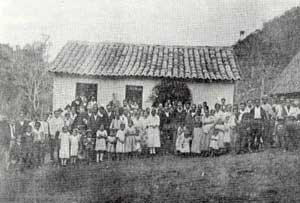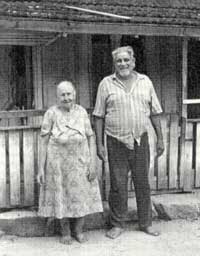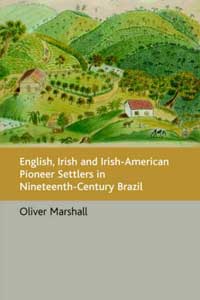|
Apparent
in any bibliography of the Irish in Latin America is the
disproportionate number of works on the Irish in Argentina
compared to the very meagre amount of research on Irish people
in other Latin American countries. With the exception of some
topics that continue to attract the attention of authors -
such as the San Patricio battalion in Mexico and Eliza Lynch
in Paraguay - an overwhelming number of books and articles are
dedicated to the Irish on the Argentine pampas.
[1] This is
the first book ever to study British and Irish emigrants to
Brazil and is, therefore, a valuable addition to the reference
books and articles already published in this area.
Above and
beyond its pioneering characteristics, Marshall’s book
represents an important piece of research for which a wide
array of primary sources was consulted in several archives in
Brazil, England and the United States. In publishing
English, Irish and Irish-American Pioneer Settlers,
Marshall is adding a new title to his already prolific list:
The English-Language Press in Latin America (London:
Institute of Latin American Studies, University of London,
1996), Brazil in British and Irish Archives (Centre for
Brazilian Studies, University of Oxford, 2002), and (as
editor), English-Speaking Communities in Latin America
(London: Macmillan, 2000).
|

A
Chamberlain-family wedding gathering, Cêrro Azul, c.
1927
(Margarida Chamberlain), p. 209. |
The author
opens his study with a discussion of emigration from Britain
and Ireland to Brazil. 'Before an immigrant-based community
can assert its identity, be it influential or assimilate' he
says, 'it has to be established. Before it can be established,
it has to be imagined' (p. 7). The ways in which the Brazilian
government, agents, priests, trade union leaders and emigrants
imagined the possibility of starting a new life in Brazil are
analysed in detail in the chapters that follow. In this
analysis, the living conditions of the English and Irish
people in England and the United States are studied in the
context of the complexity of the migration process, which
'often involves more than a simple one-way passage' (9). This
complexity and the multiple migration waves and actors, in
spite of the author's rigorous and meticulous writing,
sometimes make the book difficult to follow as a coherent
narrative, and render it more of a work of reference than a
single story of settlement in a foreign country.
Before
proceeding to a detailed description of the colonies, the
complete background of Brazilian immigration policy is
analysed for the reader, including a brief account of William
Cotter's recruitment of soldiers in Cork in 1826 and Fr. T.
Donovan's settlement of Wexford immigrants in Monte Bonito
(Rio Grande do Sul) in 1852. The key role of Tipperary-born
journalist William Scully, founder of the Anglo-Brazilian
Times and co-founder of the International Immigration
Society, is also discussed in relation to the establishment of
new colonies in Brazil.
The Irish
emigrated to Brazil from New York City, Birmingham and
Wednesbury in the Black Country of England. They were
'desperate to believe that a better life could be found in
far-off South America' (38). It was a migration scheme
conceived by promoters of agricultural colonisation in Brazil
who worked in England, and United States agents who were paid
a commission for each person sent. In Wednesbury, Father
George Montgomery was wont to preach to his poor Irish
parishioners: 'We hear our divine Saviour saying, "When they
persecute you in one state, flee ye to another," and we look
whither we may flee to obey this precept' (50). Fr.
Montgomery, together with Brazilian agents in London, imagined
'a network of New Irelands' in South America, that is,
colonies that would appeal to 'single men and lads, free,
healthy, brave, strong, generous, and disposed to live as
becomes good Catholics' (61).
There was
a stark contrast between the mid-nineteenth-century Irish and
English colonies in Brazil and the Mexican settlements of the
Irish empresarios in Texas in the 1820s, but notorious
similarities between the situation in Brazil and the Argentine
immigration policy of the 1870s-1880s.
[2]
This comparison is only mentioned in Marshall's book and
offers an opportunity for further studies evaluating the three
government initiatives in the broader context of Latin
American immigration policy in relation to other regions in
Europe. [3]
Between
1867 and 1870, many hundreds of Irish and English emigrants
were sent to Colônia Príncipe Dom Pedro, near Brusque, in the
province of Santa Catarina. Initial enthusiasm swiftly
dissolved due to ethnic conflict with German and other
settlers, lack of official support, mismanagement by the
government-appointed directors and, more than anything else,
the poor agricultural and transport facilities of the
settlement. The colony did not take too much time in
collapsing completely. By 1870, all of the Irish 'colonos' of
Príncipe Dom Pedro had left the colony. Many travelled north
to Rio de Janeiro and from there on to the United States,
where the majority settled in Pennsylvania. The English and
Irish colonists of Cananéia (São Paulo) and Assunguy (Paraná)
barely met a more fortunate fate than those in Príncipe Dom
Pedro. Their ignorance of the conditions in Brazil and the
lies of the immigration agents are best epitomised by a mother
who lost her children in appalling conditions: 'We would not
have come here for all the world if we had known' (123). These
letters also included stories of some of the immigrants'
children who were 'sold … at 5 mil reis apiece' and girls who
resorted to prostitution in order to survive (131).

Luiza da Conceição Blane and
Ernesto Fitz (Gerald).
(Oliver Marshall), p. 211. |
In the
closing chapters, Marshall offers a thorough study of the
colonies Príncipe Dom Pedro, Cananéia and Assunguy. Among
other themes, he analyses land, produce and market,
population, administration, social life, immigrant settlement,
agriculture, employment and debts, and health.
The
author's presentation of his research does not end with a
conventional conclusion. In a practical version of Pierre
Nora's lieux de mémoire, this book proposes an epilogue
which effectively links the past with the present.
[4]
Tracing the diverse destinations of the migrants and their
families, Marshall managed to locate some of their descendants
and interview them. The photographs of three generations of
the Chamberlain family, Luiza de Conceição and Ernesto
Fitz(Gerald) and João and David Davies (210-215) are a
testimony of the living presence of the English and Irish 'colonos'
in present-day Brazil, as well as of their complete
assimilation into the larger Brazilian society. Dona Luiza
'recalls her father speaking with her grandparents in a
"foreign language"'. None of the bearers of English and Irish
names today in Cêrro Azul 'have more than the faintest
knowledge (or interest) in their immigrant origins' (210). In
the appendices, the author includes a petition addressed to
Pope Pius IX by families representing several hundred of the
emigrants, a final appeal for assistance in 1898, and a list
of British immigrants in Príncipe Dom Pedro, Cananéia and
Assunguy. These documents exemplify the author's commitment to
offering primary sources together with a consistent and
helpful interpretation.
Oliver
Marshall's book is an important contribution to the study of
British and Irish diasporas, and to the research of migrations
in Latin America. Its strongest points are its inclusive
perspective that covers English, Irish and Irish-American
migrants - a point of view frequently absent from often
narrowly focused Irish historiography - as well as the
analytical tools borrowed from social, economic and family
history, together with a careful coverage of several types of
primary sources. Students of identities will find this book
extremely valuable, if somewhat arduous for beginners, in
illustrating on the basis of new examples the interesting
phenomenon of nation-building using collective imagery.
Edmundo Murray
[1]
For general and country-specific bibliographies of the
Irish in Latin America see The Irish in Latin America
and Iberia: A Bibliography. Website (www.irlandeses.org),
accessed 24 March 2006.
[2]
See Davis, Graham, Land! Irish Pioneers in Mexican and
Revolutionary
Texas
(College Station: Texas A&M University Press, 2002).
[3]
For a general reference of English-speaking colonies in
Latin America, see Platt, D.C.M. 'British Agricultural
Colonization in Latin America' in Inter-American
Economic Affairs 18:3 (1964), pp. 3-38.
[4]
Nora, Pierre, 'Between Memory and History' and 'The Era of
Commemoration' in Nora, Pierre (ed.), Realms of Memory:
Rethinking the French Past (New York, 1996-1998), 3
Vols.
Author's Reply
The
author accepts this review and does not wish to comment
further.
|




